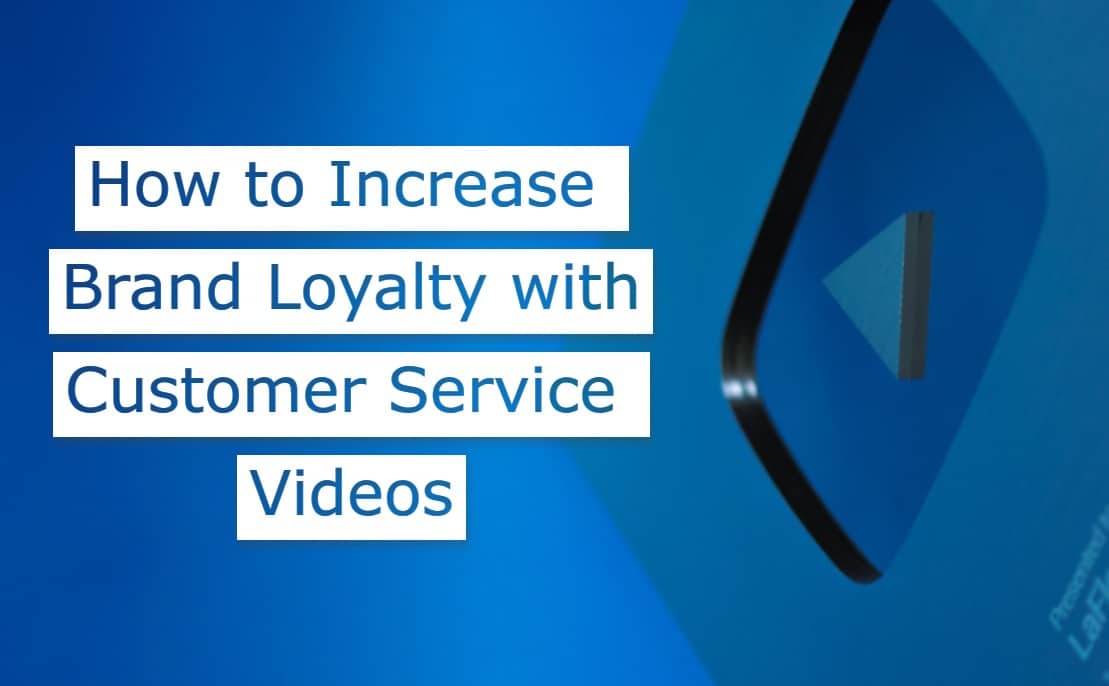Interacting with customers can be an anxiety-inducing rollercoaster ride. One of the lows of that ride can often be when customers don’t respond to your messages – even if you’re trying to actively help them.
But why?
What could possibly make them ignore you? Clearly, you did something wrong. That status report was probably unprofessional. And that EBR likely convinced them to churn. Oh, maybe it was Dave from Accounting who sent them a message without going through you first.
Feel your pressure rising? Stay calm. Breathe. Relax your face and shoulders and repeat after me: your clients’ day does not revolve around you. In fact, the most common reasons clients don’t respond to CSMs are:
- They don’t have time. Everyone has their own job and tasks to deal with, give them the benefit of the doubt, empathize, and prioritize kindness (after all, you’re often swamped by tasks too, right?)
- Their team changed. The person you usually talk to might’ve simply left the company.
- They’re waiting for internal processes. When you reach out with a proposal or something that requires approval from higher ups, expect longer wait times. After all, sometimes internal reviews can take way too long and we all know how that can go.
- They’re avoiding you. Once you’ve eliminated all other options, whatever remains, however improbable, must be the truth. In what follows, I’ll dive into some possible reasons why customers avoid CSMs and how you can tackle each one individually.
6 Reasons Why Are Customers Avoiding Your CSM and How to Deal with Them
Remember: while these may be true, they’re rarely the single source of friction between you and your customers. It’s more likely that it’s a combination of the following factors and the ones above.
1. You’re Pestering Them
Too many messages can drive anyone to ignore you. To avoid this, here are a few good rules to follow:
Determine the engagement model for each customer segment.
- High touch. Your customers need guided onboarding and constant support. Make sure you’re there for them when they reach out and as for yourself, find a good number of messages per week through trial and error. You can start by reaching out once every Monday or Friday.
- Low touch. Low-touch customers don’t need you to use your products, so only reach out when necessary or on a quarterly / monthly basis, depending on your time and the amount of help you can offer.
- Tech touch. A more complex use case, Tech-touch customers need help only in direct relation to the product. As a workaround, you can set up product triggers in your customer success automation so that you can free up space to manually reach out once a week or once a month – depending on your product, customers, and niche.
2. Your Messages Are Too Personal
B2B SaaS personalization can be a nice way to seem more in tune with your customers’ wants and needs. But it’s a double-edged sword and can actively harm you if you’re too personal. Striking a nice balance should be your top priority. Here’s some advice:
- Avoid personal information unless it’s been explicitly stated to you by the customer.
- Instead of personal info, prioritize business specifics that show customers you’ve done your research.
- Don’t just include oddly specific info without connecting it to some sort of value addition for the customer. For example, say something like: “I’ve noticed you’re having issues with customer retention in your sector right now. We can help by doing this, this, and this.”

Want to be smart when you reach out to customers? I’ve written a few more tips to effectively personalize B2B customer interactions in a recent guest article for Involve.me.
3. They Don’t Understand Your Role
While customer success is becoming an established concept, initiative, and team within customer experience and business as a whole, it’s still a fairly new topic for many. Even companies themselves seem confused about the role of a CSM, as our recent research shows 56.3% are still responsible for customer support. So at the start of your customer relationship, be sure to set the right expectations by:
- Explaining your role as a CSM and leave room to answer any questions customers might have about your role.
- Detailing all the ways in which you plan to communicate, reach out, and help out your customers.
- Explaining the difference between CS and other customer-facing roles like customer support, sales, and technical support. Many customers who want to get through to a tech person end up being sent to customer success. At that point, you start at a big disadvantage, so either facilitate their path to a tech person or solve the issue yourself if you can, but remember you’re not supposed to be responsible for customer support.
- Ask customers for their desired outcomes, find effective ways to enable their success, and track your progress along the way. And of course, don’t forget to communicate your conclusions.
When it comes to low-touch accounts, consider ways of doing this at scale such as through customer surveys and questions during the onboarding phase / product tour.
4. You’re Excessively Trying to Upsell Them
Making a customer relationship entirely transactional is not a good look, and it shows your customers you’re prioritizing their money over their success. While it might make sense as a business to want to increase your ROI, you can’t do that at the expense of your customers’ feelings lest they churn. So:
- Find appropriate times to bring up upsells and cross-sells
- For high touch accounts, set up automation flows that effectively notify you whenever there’s an upsell / cross-sell opportunity.
- For low touch, try automated, simple in-app messages to suggest upsells based on feature usage triggers. That way, it will seem like something built into the app, lessening the potential harm to your professional relationship. Don’t overdo this, however, at it will end up having the opposite effect of making the product experience worse.
Read more in our Upsell and Cross-sell Guide.
5. They Don’t Understand the Value You Provide
Adding value to help customers reach their goals should be the number one priority of CSMs. Based on that added value, your customers will upgrade their accounts, add extra features, become loyal (so lose their risk of churning), and overall increase their lifetime value.
That said, some customers might not see the value you’re adding. Maybe they’re already miles ahead of you in terms of strategy. Maybe you don’t know the product well enough yet (beginner CSMs ofter face this issue). There are a few ways around this:
-
- Be better. Yes, it’s easy to say, but also true – becoming a master at your own product and learning tactics and strategies that actually drive customer success of your organization will skyrocket your performance in CS. Practically, you can carve out time to do research and improve your skills. Talk to your Director of CS, explain that customers are not getting enough value due to lack of CS training, and figure out a strategy to improve your entire team’s skills, not just yours.
- Provide instant or first value. While you’re taking time to familiarize yourself with customer specifics and come up with a strategy, they might already be on their way out the door. Instead, figure out an early-stage value or instant value (on signup) you can provide that will convince customers that:
– They’ve made the right choice
– Having you as their assigned CSM is a value addition in and of itself - Help them during onboarding. For high-touch and even tech-touch accounts, the onboarding itself can be a moment where customers decide if CSMs provide value – so double down during that stage and optimize it.
6. You Don’t Have a Champion or They’ve Left the Company
Your champion is the person in your customers’ organization that is most-often in contact with you. Such a liaison will understand the value you provide and “champion” your business relationship and continued collaboration when talking to their higher-ups and other members of their team.
Champions often happen naturally, but to make the process easier, you should:
- Be kind.
- Be open.
- Pay attention to detail.
- Be helpful.
- Understand customer outcomes.
- Form a rapport with them.
- Be available for support.
- Add value.
However, champions aren’t forever. If at some point your champion leaves the customer’s business, plan for ways to ensure retention.
Should You Re-engage Unresponsive Customers?
A question came up during writing: is it worth it to attempt to reengage unresponsive customers? The knee-jerk answer is yes, but we decided to open it up to the CS community. Here are the results:
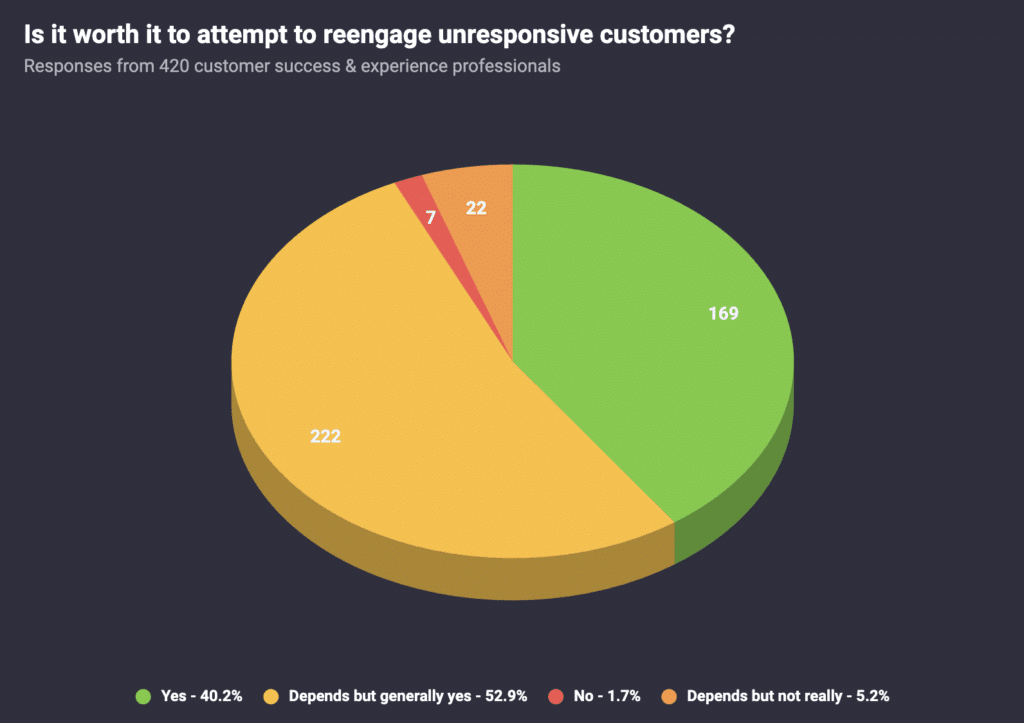
Practical Tips to Re-engage with Unresponsive Customers
Now that you’ve seen what the common mistakes are, let’s review what the CS community had to say on this topic.
Question: Do you have any practical tips to reengage with unresponsive customers from your experience?
Answers:
1. Reach Out in Good Faith
A good faith effort with multiple methods (not just email) and then it is ok to stop. Sometimes they cannot respond, it’s important to not become an annoyance. Also, when there is no response, move on to someone else and sometimes that takes creativity. Find an active person at the org and ask them politely to direct you. Half the time that non-responsive contact has moved on, or moved to a new role.
– Brian O., Digital Engagement Manager @ EgnyteI think a mild and a genuine attempt should be made but the actions should prioritize the relationship over the need to make a breakthrough.
– Abhishek Srivastav, Senior CSM @ Uniphore
Building on those quick takes, Tracey Kapshey, CS Team Lead @ Staffbase, provides a more comprehensive perspective:
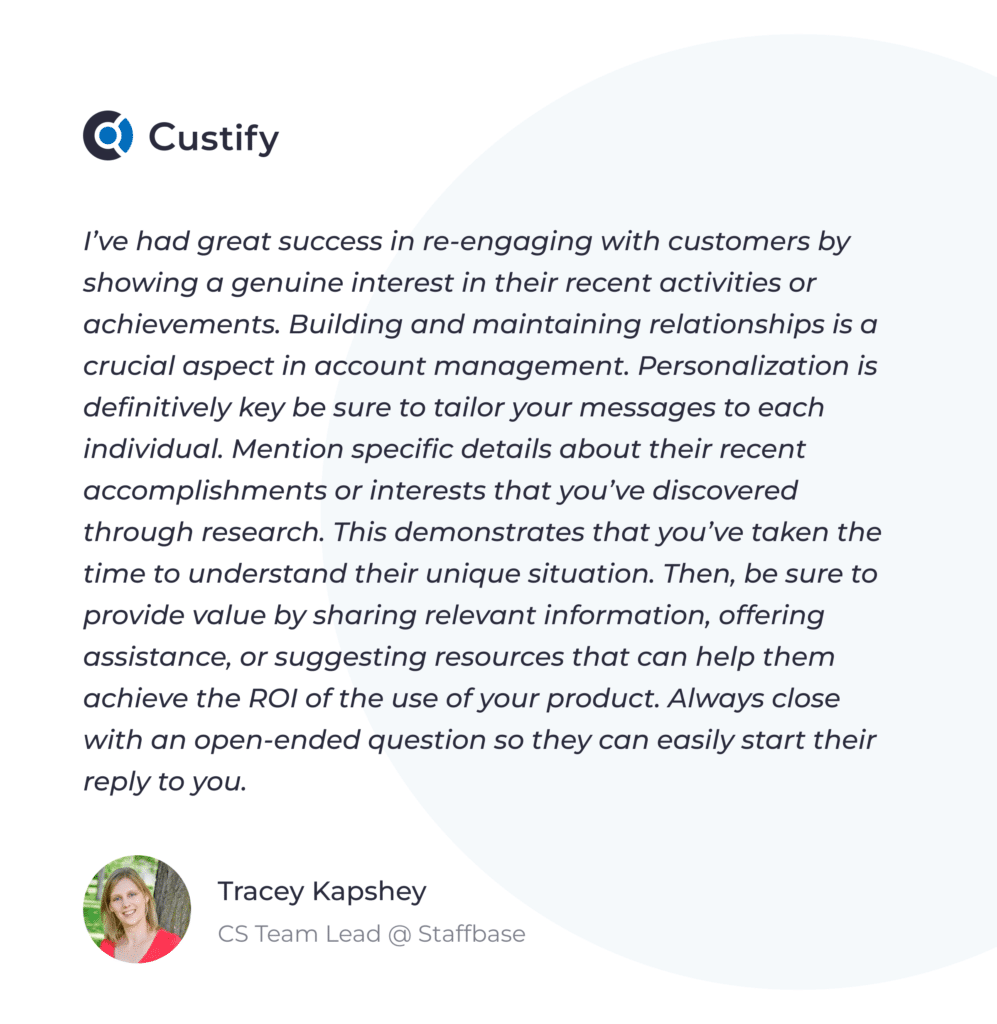
2. Send a Calendar Invite
I’ve found – with moderate success – that if I haven’t received a response in several weeks/months, I’ll send a calendar invite to have them respond to that. This is also assuming I’ve tried outreach by phone/LinkedIn as well. Even if the response to the calendar invite is “no” – it at least gives me something new to follow up on.
– Jamie Martin, Senior CSM @ Acoustic
3. Remember We’re All Human
Heather Spencer, Customer Onboarding Manager @ 1Password mentioned:
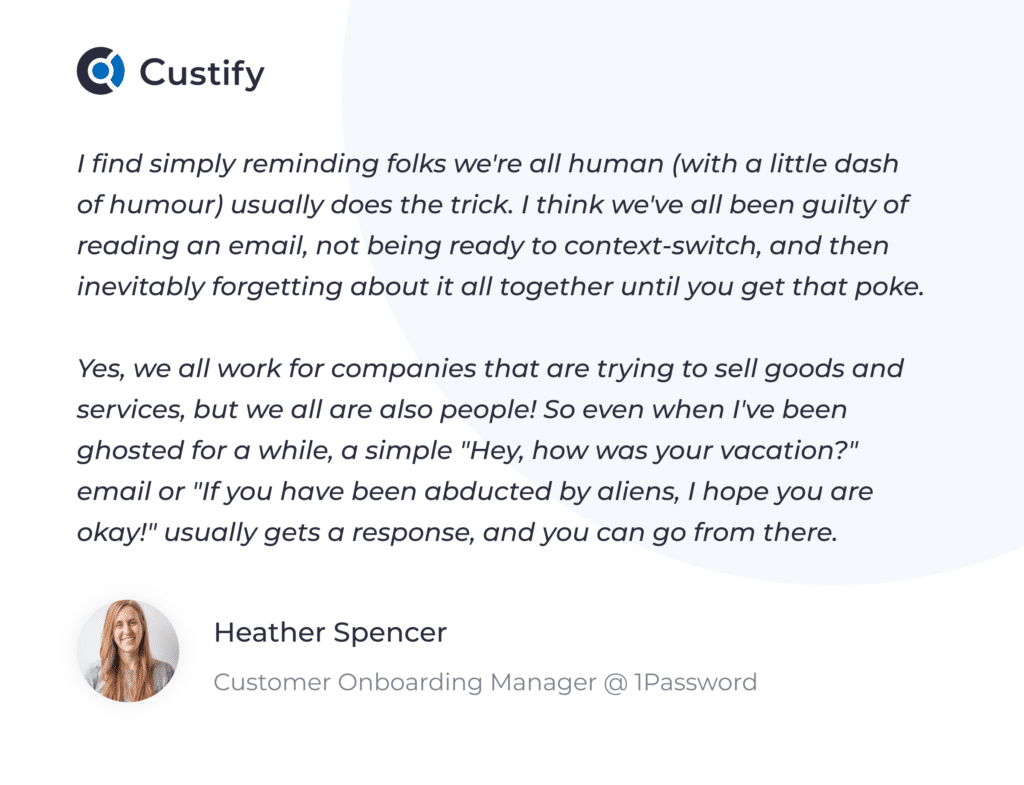
4. Return to the Initial Customer Outcome
I find going back to the reason the customer purchased the product helps. If data is available, then all the better, but generally, someone made a decision to purchase based on how they would feel once they had adopted.
If you can factor this in with the fear of not taking action, then I have found that this can re-engage the conversation and you can go from there.
– Paul Richardson, CSM @ Hectare
5. Try In-Product Banners
If they are still using your product, I have seen great success with “banners” that have to be read and can’t be clicked away easily.
– Manuel Harnisch, VP of Customer Success @ FOSSA
6. Send a Video Recording
Recording a Loom video with some positive data coming from their account, as well as showcase how new features can help them in their day-to-day.
– Samantha Semuhin, CSM @ Upflow
7. Use Data and Tools
I would say that it depends on what your particular product does. In my case, we are in appsec. I can share a finding or something that is concerning and explain why it’s concerning. I have also found that if you call someone, they pick up the phone. It’s very rare these days to get calls, but that has worked for me.
– Stacey Levine, Head of Customer Success @ APIsec
Parul Vij Chopra, Head of Customer Success @ AVATOUR stated:
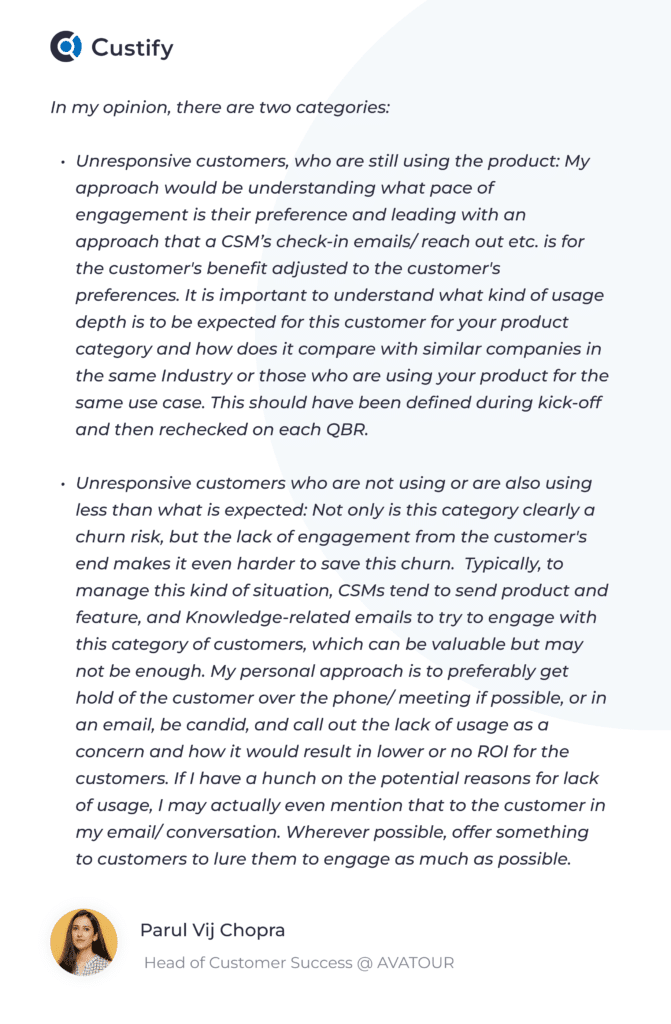
Look at their data, and pull together a list:
🔸 What are they doing well?
🔸 What could they be doing better?
Each Tuesday, send an email with the subject: “Tuesday Tips”
1️⃣ Share one thing they are doing well and how it helps them achieve their outcomes.
2️⃣ Share one thing they aren’t doing, how it could help them achieve their outcomes, and how to do it.
3️⃣ Tell them you’re available for questions and how to reach you
– Jan Young, Founder and Chief Customer Officer @ JanYoungCX, LinkedIn post continues here
I use a variety of tools –
handwritten notes
Thnks – an app we have access to; can send customers a coffee, breakfast, etc.
LinkedIn messages
Old school picking up the phone and calling
Seeking an announcement on LinkedIn about something the person is interested in and/or they posted about as a conversation starter– Magan Newton, CSM @ Vervoe
Guy Swanborough, NEMEA Territory Manager, Customer Success @ Botify mentioned:
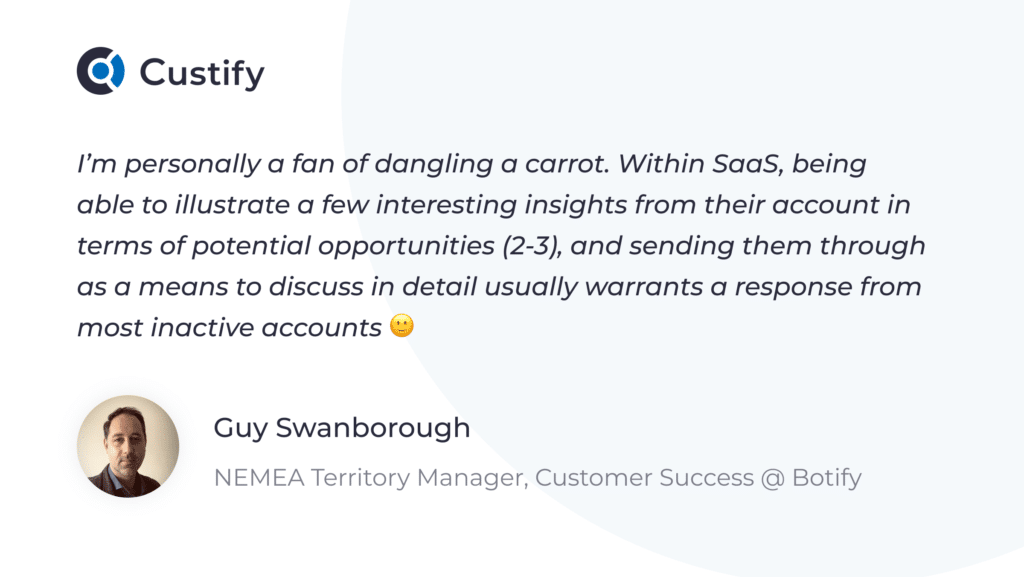
Analyze the segment they belong to and see if they tend to actually continue as a customer. If they do, look for their interest and the words that the segment uses and craft a message to the social platform they last came to you from… pretty sure you have that much data.
– Muhammad Saad Khalid, Data Specialist @ MarketLytics
8. Provide Value
Great question. While it always depends on the customer, one thing I have found is to see if there is any item of value you can present to them – a technique, a success story, a new or enhanced feature… anything that could benefit them whether they respond or not. It should show them that we are looking out for them regardless and help open some communication
– Kenneth Hopkins, CSM @ RiskOptics
I’d echo what Guy mentioned about dangling a carrot. I always try to provide value when messaging a client, rather than a standard ‘following up’ message. Alternatively, you can find others in your organisation or network who do have a relationship with the customer and use that to your advantage.
Sales are good at getting people to engage when they’ve been ghosted and this is a really good tactic.
– Richard Convery, Founder and CEO @ Ascendr Limited
9. Show Up at Their Office?!*
If all else fails and you’re wondering if they still exist, you can always try the one below?! 😅
Just show up at their office?!
– Ben Childers, VP of Global Client Success @ Engaging Networks
*This is a joke entry, don’t actually show up at their office – if they don’t want to hear from you, they likely don’t want to see you either.
Before we wrap up however, if you want to explore the topic further, here’s a useful webinar from Carmel Granahan, Founder & CS Lead at Unify Success:
Got a Reply Yet?
If your customers still haven’t replied after you’ve re-engaged following the tips above, here are some more ways to increase their response rate:
- Start a voice of the customer (VoC) initiative. Collecting feedback predictably and at scale can present a clearer picture of how clients view you. Maybe it’s not that bad, and you simply had a bad-fit customer.
- Find the right conversational balance. Using everything I’ve said, try to find a balance between personalization, tone of voice, time of reachout, number of messages, information provided, and so on.
- Make sure you add value to every conversation. Beyond convincing customers, as said in point 5 above, try to create a pattern of positive and helpful experiences that add value. If you’re successful, customers will want to keep talking to you.
- Again, don’t assume it’s about you. I’ve said this in the intro, but it bears repeating – assuming your customers’ unresponsiveness is directly tied to you is not a good mentality. Instead, be kind in all your interactions and work on the actual value addition initiatives you can implement.
Remember that at the end of the day, it all comes down to a simple question: how are you adding value to your customers?


